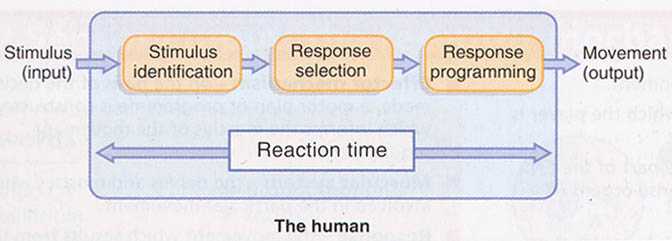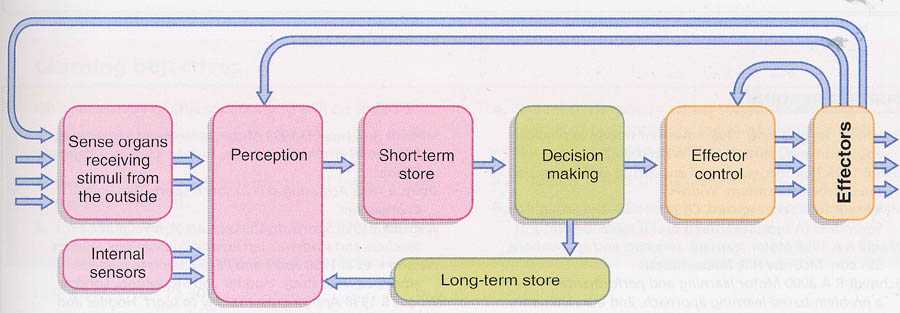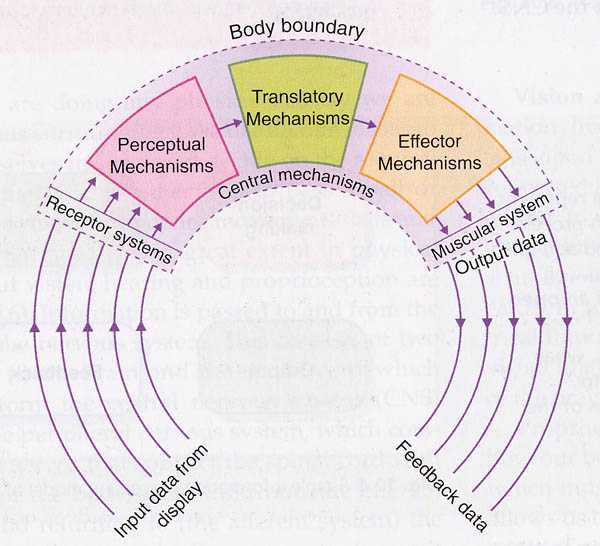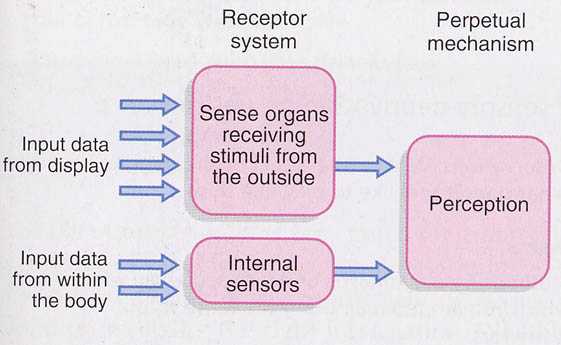| OCR Specifications 2000. Module 1. Section B: Acquiring, Performing and Teaching Movement Skills |
| AS Level PE - Skill Acquisition |
| p h y s e d |
 |
| . |
| Basic Models of Information Processing: |
| Understand a variety of models and their key components including: Schmidt (stimulus identification, response selection, response programming); Welford (display, sensory information, sense organs, perceptual mechanism, effector mechanism, response and feedback);Whiting (display, receptor systems, perceptual mechanism, translatory mechanisms, outout, feedback). |
| Mr B's scheme of work for Skill Acq (online soon) |
| Info and links in the 'A Level' zone. Check it out!! |
| Information Processing |
SENSORY AND RECEPTOR SYSTEM The part of the CNS which passes information from the sense organs to the brain. Sensory information: Information from the environment using various receptors, including sight, sound, touch and smell. Allows the performer to begin the information processing mechanism. There are three forms of receptors: Proprioceptors: Located on the nerves, muscles, tendons, joints and inner ear, which provide intrinsic information about the movement and balance of the body during the performance. The three components of proprioception are Touch � pain, temperature and pressure sense (grip on racket, struck ball hard or not etc. Equilibirum � sense of body in balance when tipping, turning or inverting etc. Kinaesthesis - sense that informs brain of the movement or state of contraction o the muscles, tendons and joints. Skilled performers know whether a movement has been performed correctly or not not only from seeing its effect but also from sensing how the movement felt to perform. Introceptors: Pass information from within the body�s internal organs such as the heart and lungs to the brain via the nervous system. This helps to regulate the various functions of the body and cater for the changing demands placed upon it. Extroceptors: Gather information from outside the body via the eyes, ears, nose and mouth. The most useful of these for a sportsperson are vision and audition, with the former being generally regarded as the most important form of receptor. Whether or not we get the right information depends on: ? the efficiency of our sense organs ? the ability to interpret the stimulus correctly, i.e. our perceptual capability. An information processing model sometimes seen in other texts and exams. Can you recognise and explain each component? ? Homework for lesson 6: 1) Identify the three main receptor systems used by you in a skill of your main activity. 2) Identify and justify the gross motor and psychomotor abilities which underpin your chosen PPP activity. 3) Apply one information processing model to your chosen PPP activity. 4) Finally, PLEASE read your notes and text book to reinforce what has been taught in the lesson. It would also beneficial if you could read the section in your text books about �memory�. ? HAND IN ALL WORK BY MONDAY ? |
| . |
| 2001 - S J Bettinson at www.physed.co.uk All comments to [email protected] |
| AN OVERVIEW of Information Processing |
| �a series of theories which seek to explain human action by showing how we take information from our surroundings and make decisions about what to do next on the basis of our interpretation of that information� (Davis et al. 4th Ed. P.297). |
| �a theory that humans deal with information that passes into the central nervous system, rather than merely responding to it. Components of the process include perception, memory, decision making and action.� (Davis et al. 4th Ed. p.429) |
| Three models to understand and be able to apply to your PPP activity |
| Schmidt |
| stimulus identification, response selection, response programming |
| Welford |
| display, sensory information, sense organs, perceptual mechanism, effector mechanism, response and feedback |
| Whiting |
| display, receptor systems, perceptual mechanism, translatory mechanisms, output, feedback |
| You must know the key components to each of the above models. |
| Exlaining Schmidt�s model of information processing: |
| Information processing involves the performer gathering data, processing the relevant stimuli to form a decision, which is then executed by the muscular system. The whole process is complex but Schmidt�s understanding of the process is to divide it into three basic stages: |
| Stage 1: |
| Stimulus identification (perception): where information is collected from the display via the sensory system and made sense of, i.e to perceive it, interpret it and identify elements in it which are important, for example whether the ball is spinning or not, what flight path of the shuttle is, whether there is a gap in the defence which can be exploited. The process of selective attention eliminates any information that is deemed relevant, i.e. the noise from the crowd is irrelevant and will not form part of the second stage of the process. |
| Stage 2: |
| Response selection (decision-making): this stage involves making a decision about how to respond to the information that has just been received. Once the player has interpreted what they are seeing, hearing, feeling, etc., they must decide on an appropriate response. Selecting an appropriate action from a number of possibilities depending on the experience and past knowledge of the performer, i.e. �my opponent has come up to the net; I�m going to lob�. |
| Stage 3: |
| Response programming: following decision making about what to do (stage 2), the muscles needed to carry out the required movement must be identified and activated. In other words, on the basis of the decision, a motor programme is constructed to inform muscles of what is required (effector mechanism). The more often a performer is exposed to a situation, the more easily he/she can respond accurately, until the skill becomes automatic. |
| Feedback |
| In order to assess the effectiveness of the decision and completed action, feedback is obtained from a variety of sources, either internally or externally. This allows the performer to develop a kinaesthetic awareness and make adjustments if required for the future if a similar situation arises. |
| Intrinsic feedback |
| information about the movement provided by proprioception (kinaesthesis etc.) |
| Extrinsic feedback |
| Information about the outcome of the response (knowledge of results - KR) |
| Beginner may not perceive errors. Beginner becomes dependent on extrinsic feedback. When feedback is withdrawn, performance can deteriorate. |
| SENSORY INPUT: THE RECEPTOR MECHANISM |
 |
| REACTION TIME the time between the onset of a stimulus and the initiation of the response. |
 |
 |
 |
| DISPLAY the total environment / surroundings from which sensory information is used. |
| Schmidt's model of Information Processing |